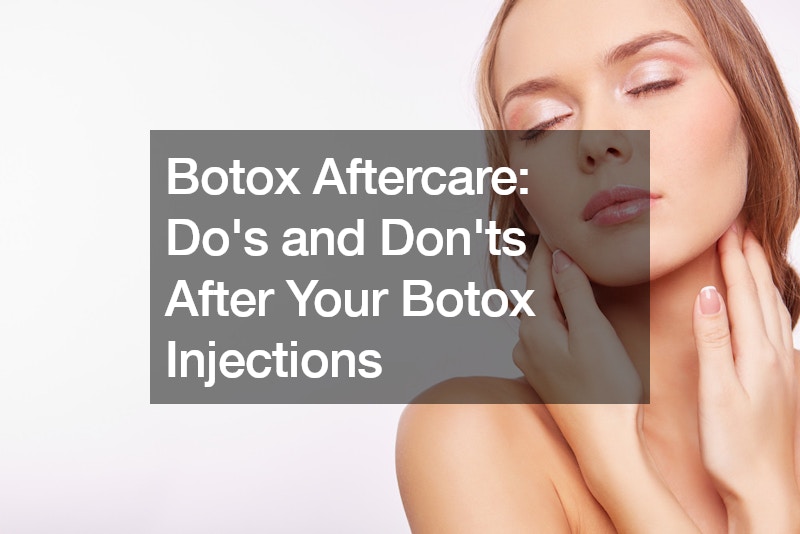

Botox injections have become a popular cosmetic procedure for reducing wrinkles and fine lines, but proper aftercare is essential to ensure optimal results and minimize potential complications. In this article, we’ll discuss the do’s and don’ts of Botox aftercare to help you achieve the best outcomes from your treatment.
Understanding Botox Injections
Before diving into the aftercare tips, let’s briefly understand what Botox injections entail. Botox is a neurotoxin derived from Clostridium botulinum bacteria, which, when injected in small doses, can temporarily paralyze muscles and reduce the appearance of wrinkles.
It works by blocking nerve signals to the muscles, preventing them from contracting and forming wrinkles on the skin’s surface.
Immediate Aftercare: What Not to Do
Immediately after receiving Botox injections, it’s crucial to refrain from touching or massaging the treated area. While you may experience slight bumps or redness at the injection sites, these typically subside within 20 to 30 minutes. Avoid covering the area with makeup as well, as this can introduce bacteria and increase the risk of infection. Remember, the tiny needle punctures create microscopic wounds that need time to heal, and any external interference can compromise the healing process.
Moving Muscles: A Helpful Tip
Contrary to popular belief, moving the treated muscles shortly after Botox injections can actually enhance the treatment’s effectiveness. For example, if you’ve had Botox injected into your forehead or frown lines, engaging those muscles by raising your eyebrows or furrowing your brow within the first hour can help the toxin penetrate deeper into the muscle tissue. Similarly, if you’ve had Botox in your jawline, chewing on a piece of gum can aid in toxin absorption.
Avoidance for the First 4 Hours
For the next four hours post-treatment, it’s essential to remain upright and avoid any activities that involve lying down or bending over. This precaution helps prevent the toxin from migrating to unintended areas and ensures that it remains localized to the targeted muscles. Whether it’s yoga, sleeping on your face, or any other position that puts pressure on the treated area, it’s best to steer clear of such activities during this time.
Cautions for the First 24 Hours
In the first 24 hours after receiving Botox injections, steer clear of strenuous exercise and excessive alcohol consumption. Exercise can inadvertently displace the toxin from the intended muscles, diminishing its effectiveness. Additionally, alcohol can affect liver function and blood clotting, potentially exacerbating bruising at the injection sites. To promote optimal healing and minimize the risk of complications, it’s advisable to take it easy and avoid rigorous physical activity and alcohol consumption during this period.
Long-Term Precautions for 2 Weeks
While Botox injections offer temporary results, it takes approximately two weeks for the full effects to become apparent. During this time, it’s crucial to avoid activities that may disrupt the toxin’s placement or cause unintended muscle movement. Refrain from facial massages, eyebrow threading, or using facial devices like ultrasound therapy or lasers on the treated areas. These activities can inadvertently move the toxin to nearby muscles, leading to undesirable outcomes such as drooping eyelids or uneven smiles.
Long-Term Maintenance
Long-term maintenance after Botox injections involves regular follow-up appointments to assess results and address any changes in facial expression. While the effects of Botox typically last three to six months, individual results may vary based on factors such as metabolism, muscle strength, and treatment area. To maintain optimal results, dermatologists may recommend scheduling touch-up treatments every three to four months or as needed.
During follow-up appointments, healthcare providers evaluate muscle movement, skin elasticity, and treatment efficacy to determine the appropriate timing for additional injections. Additionally, adopting healthy lifestyle habits such as avoiding excessive sun exposure, practicing good skincare routines, and staying hydrated can prolong the effects of Botox injections and promote overall skin health.
Combining Treatments
Combining Botox injections with other cosmetic procedures can enhance facial rejuvenation and address multiple aesthetic concerns simultaneously. For example, pairing Botox with dermal fillers can soften wrinkles and restore volume for a more youthful appearance. Similarly, combining Botox with chemical peels or microneedling can improve skin texture, tone, and clarity by promoting collagen production and exfoliating dead skin cells.
Before undergoing combined treatments, individuals should consult with a qualified healthcare provider to discuss their aesthetic goals, medical history, and treatment options. By customizing treatment plans to meet individual needs, dermatologists can achieve optimal results and ensure patient satisfaction. Additionally, combining treatments may offer cost savings and convenience compared to undergoing procedures separately, making it an attractive option for those seeking comprehensive facial rejuvenation.
Conclusion
Proper aftercare is vital for ensuring the success of your Botox treatment and achieving the desired cosmetic outcomes. By following these do’s and don’ts of Botox aftercare, you can optimize the results of your injections and minimize the risk of complications. Remember to consult with your healthcare provider or dermatologist for personalized aftercare recommendations tailored to your specific needs and concerns. With proper care and attention, you can enjoy smoother, rejuvenated skin and a more youthful appearance following your Botox injections.
.



